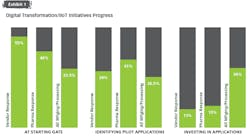A few years back, I had the opportunity to work with a pharmaceutical company looking to improve overall equipment effectiveness (OEE) across all of its global manufacturing facilities. The organization had many challenges, including personnel issues and a lack of training, as well as the fact that operational performance was not consistent across facilities.
Inspired by these challenges, the company wanted to have more visibility into the performance of its operations. That called to mind the need for a maintenance execution system (MES), delay accounting and a downtime tracking solution.
What typically happens after a company identifies the need for more visibility is a benchmarking exercise. As organizations look to tackle new initiatives, they compare the performance of facilities against worldwide standards. This comparison usually takes place before an organization is in the right place to execute consistently and match these key performance metrics. It assumes that a target, once identified and established, can be reached. The story on the ground can feel a world apart.
Finding the right pace
After listening to the different teams spread across the pharma company’s various facilities, we ultimately recommended that they design an approach that would help them improve over time. This gradual method contrasts with setting a performance goal that tracks against a target, like an objective to reach 85% of industry best practices for yield quality or material waste.
On the floor, the change in mentality that comes as a result of following a progressive approach is noticeably different from the blanket approach to best practices. The gradual approach removes the feeling of punishment or shame for underperforming benchmarks. It also keeps counterproductive practices in check, like overproducing to make up for low demand periods.
Encouraging better site performance through tangible, attainable improvements goes a long way toward helping teams to accept best practices. It is their success, after all, that is also the success of an individual site.
We eventually called this method the marathoner approach to Key Performance Indicators (KPIs) and OEE. The name came about after I watched a friend prepare for a marathon. She started with a set time for 1K and then established attainable goals at different distances (2K, 5K) that motivated her to cut time off her pace and get better. Once she found the right pace, it was easier for her to make progress on her next challenges at 10K and 20K.
OEE is a model metric for the marathoner approach because it is recorded as a percentage of quality, throughput and availability. An organization can define its targets incrementally as well as the steps it takes to get to each one.
Obviously, any organization would like to maximize capacity, but it takes time to raise the profile of a site. For this specific pharma customer, we established a sustainable baseline rate that would produce good quality products.
We level-set their OEE target (1K) so they could meet their targets consistently. That gave the site time to find its pace. This target, once achieved, also showed them they could get better. Their own progress, and the challenge that prompted the initiative, could be more easily acknowledged. It allowed them to find ways to understand where production bottlenecks were and the steps required to improve their processes, people, and even technology that would help them unlock the next levels of OEE (2K, 5K, 10K, 20K).
Taking the right approach
This is just one example of how a change management approach can be incorporated into a new system implementation. The approach establishes a data-driven method to help organizations measure performance and considers current operational conditions (work culture, personnel skills, equipment health, maintenance practices).
And, importantly, it introduces a positive approach to motivate people to get better over the course of time. All that is to say, the right tool is also the one the culture runs with.
As part of that operationalization, pharma organizations can integrate and align this marathoner approach with overall manufacturing excellence programs.




